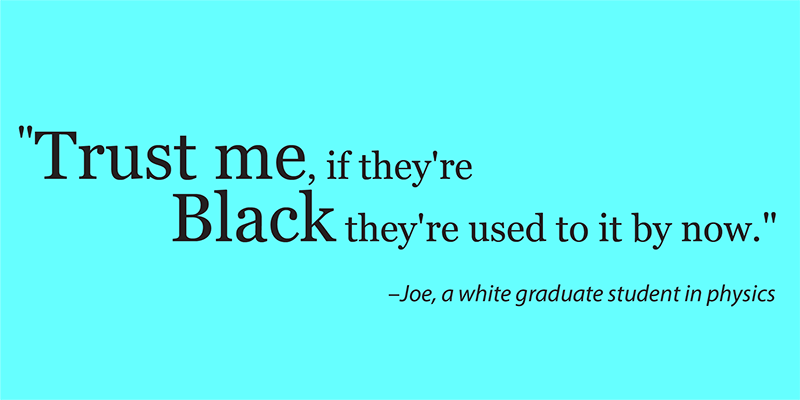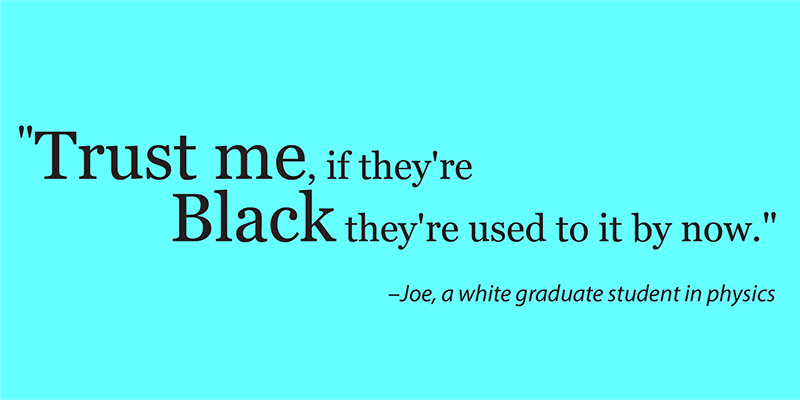See No Bias, Hear No Bias, Speak for No Change
Given time constraints, climate scientist Céline Heuzé of the University of Gothenberg, Sweden, rarely reads a scholarly paper from beginning to end in one sitting. But while traveling by train to a conference last fall, she found herself with nothing to do and decided to go through a recent preprint that had caught her eye. The experience left her in a state of fury. By the time she closed her laptop, Heuzé says that she was boiling with rage.
The preprint in question—written by Melissa Dancy of Western Michigan University and Apriel Hodari of Eureka Scientific in California—explores the role of white, cisgender (neither transgender nor nonbinary) men in perpetuating inequities in physics [1]. The study is based on interviews of several men in the physics community—their answers being the cause of Heuzé’s anger. Presented with various scenarios involving discrimination against minority physicists, the men were asked to talk through how they would respond. They were also asked direct questions on their views of the presence and prevalence of racism and sexism in their departments and in the wider physics community.
Dancy and Hodari report that the men’s answers show a consistent pattern of ignorance, inaction, and passing the buck. The interviewees persistently distanced themselves from discriminatory behaviors, minimized negative experiences voiced by minority people, and found ways to justify why they wouldn’t step in to stop harassing or discriminatory behaviors. “The men said that they understood that it’s very hard to be a woman or a minority in science. Yet, there was always this ‘but’ waiting in the background about why stopping [discriminatory] behaviors was someone else’s problem,” Heuzé says. Dancy agrees. “The guys that we talked to all genuinely seem to want the world to be fair,” she says. “But they were just so clueless as to the role they play in perpetuating inequities.”
While these findings may leave those of all backgrounds feeling as furious as Heuzé, Dancy hopes that they will also spur action that could truly lead to equity. These men are “on the cusp of getting it,” she says. If they could be educated on how to help, it would transform the field’s awareness of racist, sexist, and other discriminatory behaviors. “Then we could have meaningful change,” she says.
Blinded by Privilege
In their study, Dancy and Hodari analyzed interviews of 27 men who had responded to an email advertisement shared with various faculty and graduate student networks. These men all identify as white and cisgender, a group that—across society—has the most privilege and power. (In the US, it has the highest level of social inclusion, professional respect, career advancement opportunities, and annual salary while experiencing the least harassment at work.) The men also all identify as progressive and say they want to reduce discrimination in society.
Each man was asked a series of questions that explored his knowledge, beliefs, and experiences with race and gender issues in the context of physics. The interviews were conducted by four white men—a choice made by Dancy and Hodari so that the interviewees would feel comfortable to speak completely honestly, which might not happen if the questions came from a white woman (Dancy) or a Black woman (Hodari).
To analyze the transcripts, Dancy and Hodari used a framework known as critical discourse theory, which looks at the words people use and the way that they use them. The duo flagged phrases that related to sexism and racism and then gave each of those phrases a tag based on the specific biases that were expressed and on the reasons for those biases.
The analysis revealed endemic racism and sexism, with all but one interviewee conveying biased views, which Dancy says shocked her. “I was surprised by how frequently the men said things that made me say out loud, ‘What the fuck.’” To elaborate, Dancy talks through one of the study’s questions. The participants—who were all given pseudonyms for the study—were asked to interpret a text that described the following scenario: A Black woman student reports that she consistently sits alone in physics seminars; if she sits in the same row as other students in one lecture they will have moved to a different row in the next class. She says that she finds the behavior upsetting and isolating. Other Black women students have reported similar behavior.
Paul, a tenured professor, said, “If I were her, I’d just be like okay, this is the world that we live in.” He continued, “Maybe she wants to sit alone.” Paul rejects the validity of the student’s feelings, implies that she is responsible for the exclusionary behavior of her peers, and indicates that he wouldn’t step in because he doesn’t think it would have an impact. Dancy finds Paul’s response absurd. “The student clearly states that she doesn’t want to sit alone and that she isn’t okay with the behavior of the other students,” she says. She had a similar reaction to the answer of Joe, a graduate student, who said explicitly that he wouldn’t do anything because the woman might not want him to, adding, “Trust me, if they’re Black they’re used to it by now.” Dancy says that she can’t understand how Joe finds this response acceptable.
It’s Not Me—It’s Them
Delving further into the responses, Dancy and Hodari found that the main way that the men justified their inaction was by distancing themselves from racist or sexist acts—the discriminatory behavior occurs in places where they have no influence. Some did this by noting that their department had recently undergone diversity training, so harassment couldn’t be happening in their lab. Others blamed sciences’ “bad rap” on fields other than physics. For example, when presented with data demonstrating race- and gender-based discrimination in all fields of science, Mark, a tenured faculty member, pinned the blame on those “in computers” where “there are some pretty serious ‘bro’-type cultures.” Joe pointed the finger at nonphysics students taking physics classes as electives.
These claims are all at odds with data collected by the American Institute of Physics that show that sexism and racism in physics are pervasive and are present in every institution and in every subfield. By framing the problem as being physically distant, the individuals relieve themselves of a responsibility to act, Dancy says.
Even when interviewees were confronted with situations over which they had direct influence, the participants rarely said that they would intervene. The reasons for this inaction ranged from being uncomfortable with confrontation to feeling that they lacked the seniority to step in. In one notable case, Brent, a tenured professor, expressed surprise when during the interview it was noted that there was only one woman in his research group of 40. “I never even thought about it,” he said.
Jarita Holbrook (they/them), a Black cultural astronomer at the University of Edinburgh, UK, notes that they have spent a large part of their career listening to justifications from white colleagues for why they were unable to take substantive action against discrimination. “Those with privilege get to participate in cultural change on whatever terms they want,” they say. “They can engage, they can disengage, they can walk into a talk on equity and diversity and, if they don’t like it, they can walk right back out, they have that luxury.”
Flawed Model of Change
When it comes to leveling the physics playing field, most initiatives follow the same route: identify a disadvantaged group and coach them on how to step up, work harder, and stay strong (see News Feature: Fixing a Physics Culture Problem). And when that group doesn’t meet the goal, the blame for any inequities can fall on their shoulders. Heuzé recounts a case where she was asked to join a committee after another woman left. She agreed, but only if she wouldn’t be the only minority member of the group. That request did not go down well. “I was told, ‘There is never going to be progress if, whenever we ask a woman [to participate], she says “no,”’” Heuzé says. “The gender inequality [on the committee] became my fault for not ‘doing my part.’”
While anecdotal, Heuzé’s experience is backed up by studies that consistently show that, if a person from a minority group tries to bring attention to discrimination, there is a backlash against that person. On the flip side, studies show that white men are more likely to pay attention to opinions of other white men than to those of people from minority groups. Dancy notes that as a white woman she has found that people tend to take her seriously when she discusses racism, whereas her input on gender inequality is often labeled as whining and then rejected.
Dancy and Hodari offer several recommendations on how to make issues of inequality more difficult to dismiss. The primary recommendations are to make people of privilege the target of change and to demonstrate to them how their actions—or inactions—make them complicit in discrimination and exclusion. Those with privilege have the power—and the responsibility—to spearhead change, Dancy says.

Another recommendation is holding to account those who display biased actions. “All of our participants were able to exist in and succeed in their field without having their ignorance significantly challenged,” Dancy says. “If white men can advance while remaining ignorant or even oblivious of sexism and racism, inequity will remain.” Thus, Dancy and Hodari argue that research groups, physics departments, and universities need to create, implement, and enforce structures that make people answerable for their behaviors.
Michael Marder agrees with this assessment. Marder, a physicist at the University of Texas at Austin, was the inaugural chair of the American Physical Society’s (APS’s) Ethics Committee. He helped develop policies and procedures that create consequences for professional conduct, such as stripping transgressors of APS awards, prizes, or fellowships; removing them from official leadership positions; or excluding them from APS meetings. “We need a great sense of humility regarding our ability to reform ethical practice,” Marder says. “The pressures on people to commit ethics violations involve some of the deepest human motivations that there are—the desire for power, the desire for money, the desire for advancement. Awareness alone will not counter these things.”
That Dancy and Hodari made explicit recommendations for interventions that go beyond awareness is what grabbed the attention of Tatiana Ilyina, a climate scientist at the Max Planck Institute for Meteorology, Germany. Dancy and Hodari didn’t simply present the problem; they also explained how to solve it, she says. And, as recommendations go, Ilyina thinks that these should be relatively simple to achieve. Even if only one white man reads the paper and realizes these changes, Illyina can see it having an immediate impact on the culture of his research group or his institution. “As a climate scientist, I often get asked, ‘how can one person make a difference?’ I hear the same question for diversity,” she says. “Here they show that what one person can do is very important.”
Not Always the Smartest in the Room
The response to the paper has been generally positive. On social media, some people commented that the paper itself was racist. Most commentators, however, praised the study, sharing reflections on their own actions or encouraging others to read the paper. “It’s a phenomenal piece of work that I already refer to in my own research,” Holbrook says.
Pablo Bianucci, a white, cisgender physicist at Concordia University, Canada, says that on reading the paper he immediately recognized himself in some of the participants’ answers, particularly when it came to distancing himself from sexism and racism. “I know [discrimination] is bad overall, but I always thought that where I was working was doing pretty good,” he says. “But I actually have no idea what the climate is like in my department for those who aren’t white men.”
Since reading the paper, Bianucci has reached out to minority colleagues to learn about their experiences and is currently figuring out how to get wider input from minorities. He also has plans to make equity, diversity, and inclusion a key part of the hiring process when he cycles onto his department’s hiring committee. “The paper made me realize that even if the white man we interview looks like the best fit—he has a good research history and studies the right things—he might not be if we end up in the same poor patterns,” Bianucci says. “I now think it’s a lot more critical and urgent to have diverse hires.”
Marc Robinson-Rechavi, a biologist at the University of Lausanne, Switzerland, who identifies as white and cisgender, also plans to incorporate the recommendations of the paper in his role as director of his research department. In particular, he wants to avoid the trap that many successful male academics get into—thinking that they know more than the people around them. “I think that [hubris] is a big part of the problem,” he says. To improve the equity in his department, he will be turning to minority colleagues. “Listening is really important.”
Correction (6 March 2023): An earlier version of the story featured a Tweet from Chanda Prescod-Weinstein. The comment was removed at her request.
–Katherine Wright
Katherine Wright is the Deputy Editor of Physics Magazine.
References
- M. Dancy and A. Hodari, “How well-intentioned white male physicists maintain ignorance of inequity and justify inaction,” arXiv:2210.03522.







